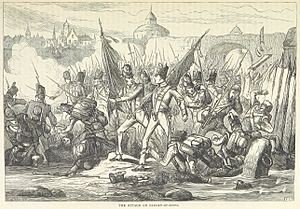Siege of Bergen op Zoom (1814) facts for kids
Quick facts for kids Siege of Bergen op Zoom (1814) |
|||||||
|---|---|---|---|---|---|---|---|
| Part of the War of the Sixth Coalition | |||||||
 British illustration of the attack |
|||||||
|
|||||||
| Belligerents | |||||||
| Commanders and leaders | |||||||
| Strength | |||||||
| 2,700 | 4,000-9,000 | ||||||
| Casualties and losses | |||||||
| 500-600 killed, wounded, or captured | 920-1,900 killed and wounded 2,263 captured |
||||||
The Siege of Bergen op Zoom was a big battle that happened on March 8, 1814. It was part of a larger conflict called the War of the Sixth Coalition. In this battle, a British army led by Thomas Graham, 1st Baron Lynedoch tried to capture the city of Bergen op Zoom from a French army. The French soldiers were commanded by Guilin Laurent Bizanet and Jean-Jacques Ambert.
Bergen op Zoom is a port city in the Netherlands. It is about 70 kilometers (43 miles) south of Rotterdam. It is also about 40 kilometers (25 miles) north of Antwerp in Belgium.
The British army managed to break into the city's defenses at first. However, the French army fought back very well. They forced many of the British soldiers to give up. In the end, the French won this battle.
Contents
The Attack on Bergen op Zoom
The French General Guilin Laurent Bizanet had about 2,700 soldiers defending Bergen op Zoom. The British commander, General Graham, decided to attack at night. His troops used information from local people to help them.
French Defense and British Challenges
Even with the element of surprise, the French were ready. They had set up their defenses well. The people living in Bergen op Zoom also helped the French soldiers. They fought alongside them in the streets. This made the battle very difficult for the British. The attacking British troops suffered many injuries and deaths. General Bizanet kept control of Bergen op Zoom. He held the city until a peace agreement was signed later.
Soldiers and Losses
General Bizanet was the main commander for the French. Jean-Jacques Ambert was also a French leader in the battle. The French army had 2,700 soldiers. About 500 to 600 of them were killed or wounded. Another 100 French soldiers were captured.
British Forces and Casualties
The British army was much larger. Different reports say they had between 4,000 and 9,000 soldiers. The British suffered heavy losses. Between 2,100 and 4,000 British soldiers were killed, wounded, or captured. A large number, 2,263, were taken prisoner by the French.
British Battle Plan
General Graham organized his British troops into four main groups, called columns. Each column had a different leader and different units of soldiers.
| Commander | Unit | Number of Men | |
|---|---|---|---|
| 1st Column | Colonel Lord Proby | Brigade of Guards | 1,000 |
| 2nd Column | Lieutenant-colonel Morrice, 69th Foot | 55th Foot | 250 |
| 69th Foot | 350 | ||
| 33rd Foot | 600 | ||
| 3rd Column | Lieutenant-colonel Henry, 21st Foot | 21st Foot | 400 |
| 91st Foot | 100 | ||
| 37th Foot | 150 | ||
| 4th Column | Brigadier-general Gore / Lieutenant-colonel Carleton | 44th Foot | 300 |
| Flank companies of the 21st and 37th Foot | 200 | ||
| 1st Foot | 600 | ||
| Total | 3,950 |

